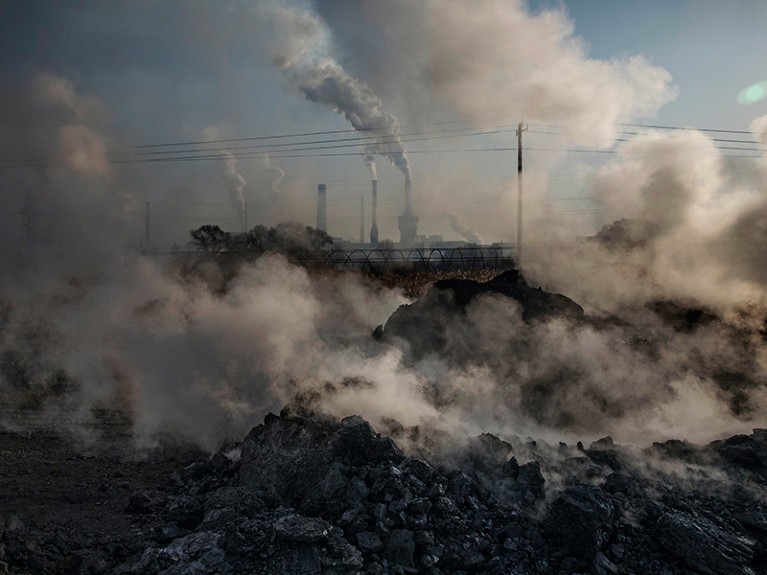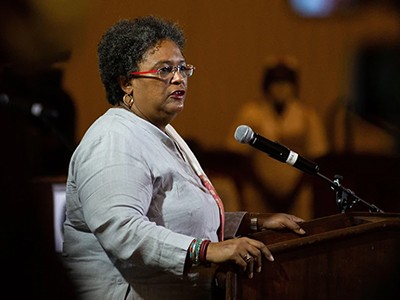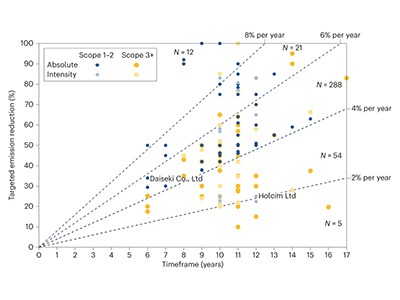
At COP28, companies have pledged to decarbonize their operations — but not to reduce emissions from burning fossil fuels.Credit: Kevin Frayer/Getty
A few days into the 28th United Nations Climate Change Conference (COP28) in Dubai, 50 oil and gas companies made a widely reported pledge to decarbonize their operations by mid-century. This is a start of sorts, but nothing like phasing out actual emissions from burning oil and gas. And even when companies do pledge to cut their operational emissions, it is hard to tell what they mean in practice. They are rarely transparent about the reasons they choose a particular methodology for calculating emissions reductions, or about the underlying data used.
A 2021 study1 analysed publicly available emissions disclosures from 52 oil and gas companies, many of which have made grand emissions-reduction claims. Simon Dietz at the London School of Economics and Political Science and his colleagues estimated these companies’ future emissions intensity — a measure of greenhouse gases released per unit of activity — and compared their trajectories with scenarios that meet the goals of the 2015 Paris climate agreement. They found that the companies are not setting targets that are ambitious enough or cutting emissions fast enough to meet the Paris aim of limiting global warming to well below 2 °C above pre-industrial levels.
Shortly after COP26 in Glasgow, UK, in 2021, UN secretary-general António Guterres established an expert group to quell greenwashing — attempts by companies or others to seem more environmentally friendly than they actually are. The group’s remit was to advise all ‘non-state entities’ — businesses, but also local and regional governments — on best practice in emissions disclosure. Chaired by former Canadian climate minister Catherine McKenna, the group issued a report, ‘Integrity Matters’, calling for “radical transparency” in setting targets (see go.nature.com/3kzyucn).
Beyond greenwashing: how to make business and finance genuinely sustainable
Researchers need to rise to this challenge by scrutinizing disclosures, targets and metrics for progress, and advising on what they should look like. Some are already doing this, but a lot more needs to be done to objectively verify what companies are — and will be — claiming. One of the groups leading efforts to create standards in this area is the Science-Based Targets Initiative (SBTi), a partnership between non-governmental organizations including the World Resources Institute in Washington DC, and the CDP (formerly the Carbon Disclosure Project) in London.
The SBTi makes recommendations to companies on best practice for setting carbon-reduction targets. It has assessed such targets for more than 2,000 companies across 6 continents, verifying that they are in line with the Paris goals. But researchers say that there needs to be more transparency, both in how the SBTi creates its recommendations and in companies’ goals.
When companies set emissions-reduction targets, they lay out an emissions pathway that they will follow to achieve that target. Some pathways are more ambitious than others, according to studies2,3 by SBTi technical-council member Anders Bjørn at the Technical University of Denmark in Kongens Lyngby and his colleagues. But in a Comment4 for Nature Climate Change in July, the research group found that the SBTi doesn’t clearly disclose why it recommends particular methods and pathways, and companies don’t disclose which of its recommended methodologies they use, or why. Moreover, not all companies make their data inputs public. Not knowing these details makes it harder to check or reproduce the results. Asked about this, the SBTi told Nature that the methods and calculations for setting targets are made public and that it requires companies to disclose emissions data and progress against targets. But it says it doesn’t prescribe which platforms or channels companies should use to report this information.
Other research has raised further questions. For example, an emissions-reduction target needs to include a base year from which to measure progress. The SBTi gives companies freedom to choose this year, according to a study5 by Saphira Rekker at the University of Queensland in Brisbane, Australia, and her colleagues. But that means there will be inconsistency in reporting standards.
Increased transparency is needed for corporate science-based targets to be effective
Furthermore, if a company gets off track, it needs to readjust its target to make up for the deficit. But the SBTi does not mandate this in its recommendations. The researchers say that companies using SBTi methods to set targets might not be on track with the Paris goals. In response, the SBTi told Nature that it fully supports the idea of adjusting targets to reflect deviations. But it added that an annual review process would be too time- and cost-intensive, and that it has a five-yearly review process instead.
The SBTi is in a tricky position. It wants to encourage companies to report ambitious and accurate voluntary emissions targets. But it’s unclear how well they are actually doing. Greater distance between the SBTi and companies might help, which is where scientists could step in. The SBTi’s scientific advisory group, which is made up mostly of climate and global-change scientists, is looking for new members. The initiative is also convening expert groups to advise on projects such as developing guidance for specific sectors. Researchers should take the opportunity to join.
Businesses are under increasing pressure as several jurisdictions seek to make carbon reporting mandatory. Starting next year, large companies in the European Union will be required to make public their climate and other environmental impacts through the Corporate Sustainability Reporting Directive. Rules enacted in California and being developed by the United States Securities and Exchange Commission could do something similar. Researchers must provide their insights by submitting to public consultations and scrutinizing how rules are applied in practice. This input will be key to ensuring that efforts are based on a consensus of the best available evidence — and that carbon-accounting methodology and accepted data sources are included when companies publish their reports. Governments and other authorities must be more proactive about reaching out for researchers’ help in shaping policies.
Corporate climate reporting has come a long way but greenwashing remains a live concern. The McKenna report rightly urged that progress must be subject to independent evaluation against targets and strategies. Researchers clearly have more work to do to help ensure that the promise of a greener future becomes a reality.

 Beyond greenwashing: how to make business and finance genuinely sustainable
Beyond greenwashing: how to make business and finance genuinely sustainable
 Increased transparency is needed for corporate science-based targets to be effective
Increased transparency is needed for corporate science-based targets to be effective
 Measuring corporate Paris Compliance using a strict science-based approach
Measuring corporate Paris Compliance using a strict science-based approach





